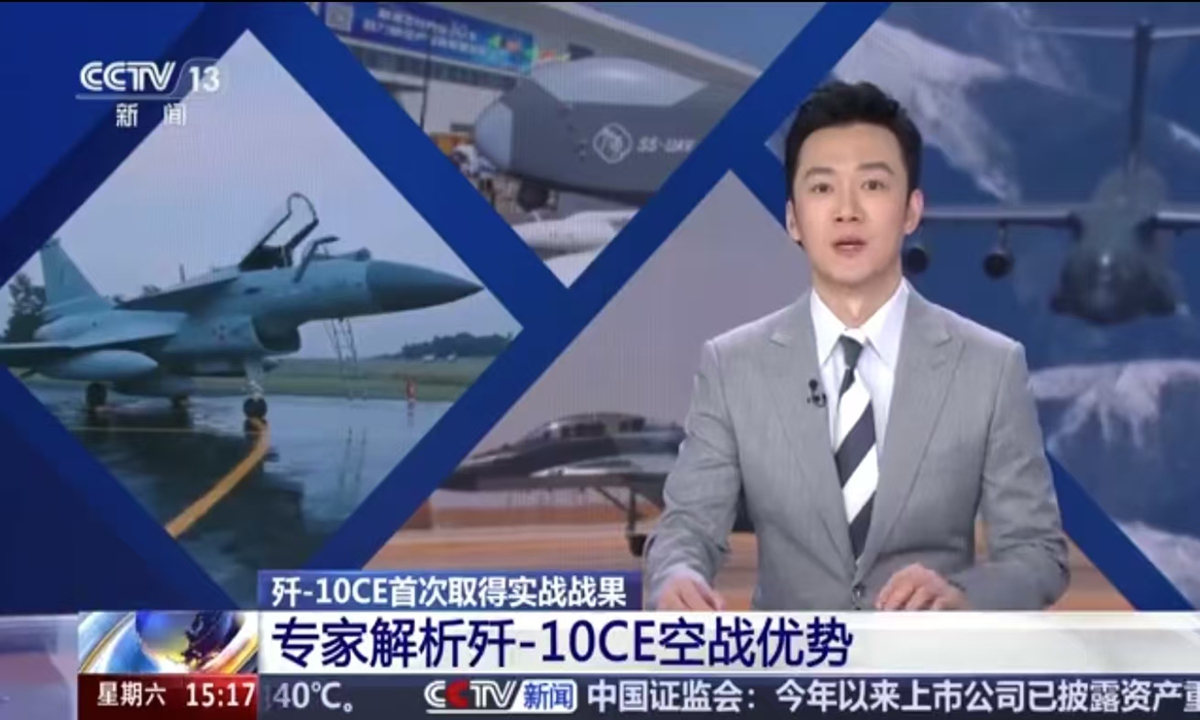
Photo: Screenshot from China Central Television (CCTV) News
Recently, major media outlets have focused on the news that China's made-for-export warplane, the J-10CE, has recently achieved its first real combat success. Experts explain that the J-10 series possesses key advantages, including high maneuverability, strong stealth capabilities, a long radar detection range and advanced missile systems. These strengths enable the aircraft to detect, track and strike the enemy first. The J-10 is widely regarded as a true "fighter of national pride" in the history of China's aviation industry. It once again showcases the determination, integrity and confidence that underpin China's commitment to self-reliance and self-improvement in science and technology.
The birth and growth of the J-10 is, in itself, a history of striving for independent innovation. In the 1980s, when the project was initiated, China's industrial foundation was weak and funding was limited. There were voices questioning whether the project was worth the investment, suggesting that it would be easier to buy foreign jets and simply retrofit them. Additionally, there was the passive setback of an intended US collaboration to upgrade the J-8, which was abruptly revoked. At a time when mainstay fighter jets around the world - like the American F-16, the French Mirage 2000, and the Sukhoi's Su-27 - were advancing into third and even fourth generations, Chinese pilots still had to rely on maps and compasses for long-distance flights. Faced with this reality, Chinese aviation engineers made a firm decision: "Don't wait, don't rely on others, and never expect foreigners to help us." They embarked on a path of independent innovation.
The successful development of the J-10 fighter jet marks a significant enhancement in China's aviation industry's ability to independently research and develop advanced fighter aircraft at a world-class level. While international convention limits the proportion of new technology required for a new aircraft to under 30 percent, the J-10 broke through with a ratio of over 60 percent. It also achieved a remarkable milestone in flight test history: zero casualties. This speaks volumes about the technical value and safety of the J-10 as a domestically developed fighter. J-10 fighter entered service in 2006 and began to build real combat capability.
This fighter jet, known as the "fighter of national pride," embodies the humiliation of the "Yinhe Incident," the fury over the bombing of the former Chinese Embassy in the Federal Republic of Yugoslavia, and the grief and honor of martyr Wang Wei's heroic sacrifice. It transforms national pain into the driving force for strength and progress. Generation after generation of Chinese aviation engineers, with a spirit of quiet dedication and step-by-step determination, have made it possible for Chinese fighter jets to evolve from trailing far behind to standing shoulder to shoulder with the world's best. This is a testament to the hard-core spirit of the Chinese people: The greater the challenge, the stronger the resolve.
Not only in the aviation industry, but also upholding the spirit of self-reliance and self-improvement, China continues to make breakthroughs in basic research and cutting-edge technology: The Tianmouc chip outperforms traditional visual algorithms; the Sunway TaihuLight supercomputer once led the world; the Origin Wukong, equipped with a quantum computing operating system, has opened a new era of quantum computing power; the launch of 12 satellites for the Space Computing Constellation 021 mission marks the beginning of the global "Space Computing Era"; the deep-sea manned submersible Fendouzhe (Striver) has explored the depths of the ocean; the Tianhe core module is building dreams in space, achieving long-distance quantum communication over thousands of kilometers between space and Earth for the first time; the C919 large passenger aircraft soars through the sky, and the high-speed maglev train reaches speeds of 600 kilometers per hour, setting a new record for "China Speed." China's overall scientific and technological strength and international competitiveness continue to rise, and the world has witnessed the transformation of "Made in China" to "Intelligent Manufacturing in China."
China firmly holds the initiative in technological development while also understanding the significant importance of open cooperation for its own growth and global prosperity. More and more countries are recognizing that "choosing China means choosing the future." Whether in aerospace, 5G, or new energy sectors, China's cooperative projects with the world, especially with many countries in the Global South, are thriving. In the aviation sector, the China International Aviation & Aerospace Exhibition, also known as Airshow China, has become a key platform for attracting domestic and foreign businesses to engage in discussions about advanced aerospace technologies. The C919 aircraft's entry into Southeast Asia adds positive momentum to meet local development needs. A large number of Chinese low-altitude economic enterprises are establishing a presence in Gulf countries to promote sustainable development, demonstrating China's commitment to benefiting the world through technology.
Looking back at the journey, China's aviation industry has risen from nothing to rank among the world's leaders, relying on its unwavering commitment to independent innovation and persistent effort. Looking ahead, as the world experiences changes unseen in a century, China's technological development is bound to encounter broader opportunities for growth. China will always embrace the world with an open heart, contribute Chinese wisdom to global technological development, and provide a solid technological foundation for maintaining world peace and development.


